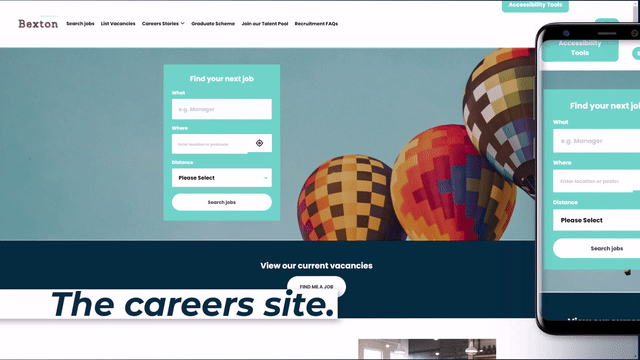1 - What is a careers website?
2 - How to set up a careers site
3 - What should be included on a careers site
Candidate engagement attraction should be number one (or close to) on all recruiters’ to-do lists – and that’s where a well-crafted careers website comes into its own. It acts as a shop window for showcasing your EVP (Employee Value Proposition), culture and job opportunities.
Our Talent Intelligence survey of candidates found 15% of candidates who applied for a job did so because they were influenced by what they read on the company’s careers website (JobBrain™).
Following the release of our guide (How to deliver the ultimate candidate experience), we’re here to include our top tips on meeting your candidate engagement and attraction goals and bringing your Careers website into the twenty-first century.
What is a careers website?
A careers website can be many things. In simple terms, it’s an area of an organisation’s corporate website (or linked to from the corporate website) that’s dedicated to providing information to prospective candidates.
It’s an opportunity to show potential hires what it’s like to work at an organisation, the opportunities available, the benefits to them if they chose to work there and what peoples’ experience of working there is like (in their own words).
How to set up a Careers Website
Careers website content (and presumptive costs) are sometimes seen as a barrier, but it doesn’t need to be a fully bespoke website to be just as effective.
Starting from scratch or simply just refreshing an existing careers website – it doesn’t have to be an onerous or expensive task.
To start, a simple page that covers the basic Careers information is a great first step if it’s your first time setting one up. Many applicant tracking systems (including Jobtrain) can include a careers website builder as part of the package, giving you the freedom and flexibility to create and manage your own content in your own time.

Creative content for the site may not come naturally to HR and recruitment teams – so ask your own in-house experts if it becomes a challenge! Your Marketing team create content all the time, so get them onside and engage with them for their help. Not only is the new website content going to be available for prospective candidates to see, but it can also be reused in your recruitment social media campaigns too.
What should be included on a careers website?
Have in mind that the objective of any careers content is to drive engagement and attraction with prospective candidates.
If it’s done well, the content should educate candidates on whether they think they’re a good fit for the organisation and decide if they want to apply for a job in the first place (or encourage them to apply!). For instance, by showcasing your company culture it can help candidates decide if it’s for them - you'll then only need to concentrate on those who are a fit for what you’re looking for.
.jpg?width=1500&height=900&name=Post%20(3).jpg) Include information that showcases your EVP
Include information that showcases your EVP
89% of prospective candidates agree that an employer’s careers website is important for finding key information (Careerbuilder).
Make sure your company's values, culture and mission are included. Similarly include benefits, information on careers paths, employee testimonials, photos and videos to give an insider’s take on what it's like to work for you.
The adage ‘people buy from people’ is just as true in recruitment. A quick video on your careers website (recorded on a mobile phone will more than suffice) of current employees talking about their experience will drive 8 x more engagement from potential hires. Videos are valuable – they’re real, authentic and relatable for prospective candidates.
Make sure it’s accessible on mobile devices
Many prospective candidates (at least initially) will use a mobile phone to research an organisation and search for jobs. In fact, a Glassdoor study revealed that 58% use their mobile devices to search for jobs, so ensuring your careers site is mobile-friendly and easy to navigate on any device is critical.
Incorporate social media and employee referrals
Use your prospective candidates’ networks (and your own employees’) to broadcast your careers content even further. By adding social media sharing buttons and employee referral options within your career content, a lot of the hard work could already be done for you by expanding your reach and tapping into passive candidate networks.
Provide a dedicated section for frequently asked questions (FAQs)
Answer the most common candidate questions and concerns in a dedicated FAQ section on your career site. It should help you convert more prospective candidates into applicants by removing any doubt in candidates’ minds. It can also help reduce candidate uncertainty, reduce the queries into your hiring team and ultimately improve the quality of candidates that apply.
For the ultimate guide on delivering a great candidate experience, download our guide.

